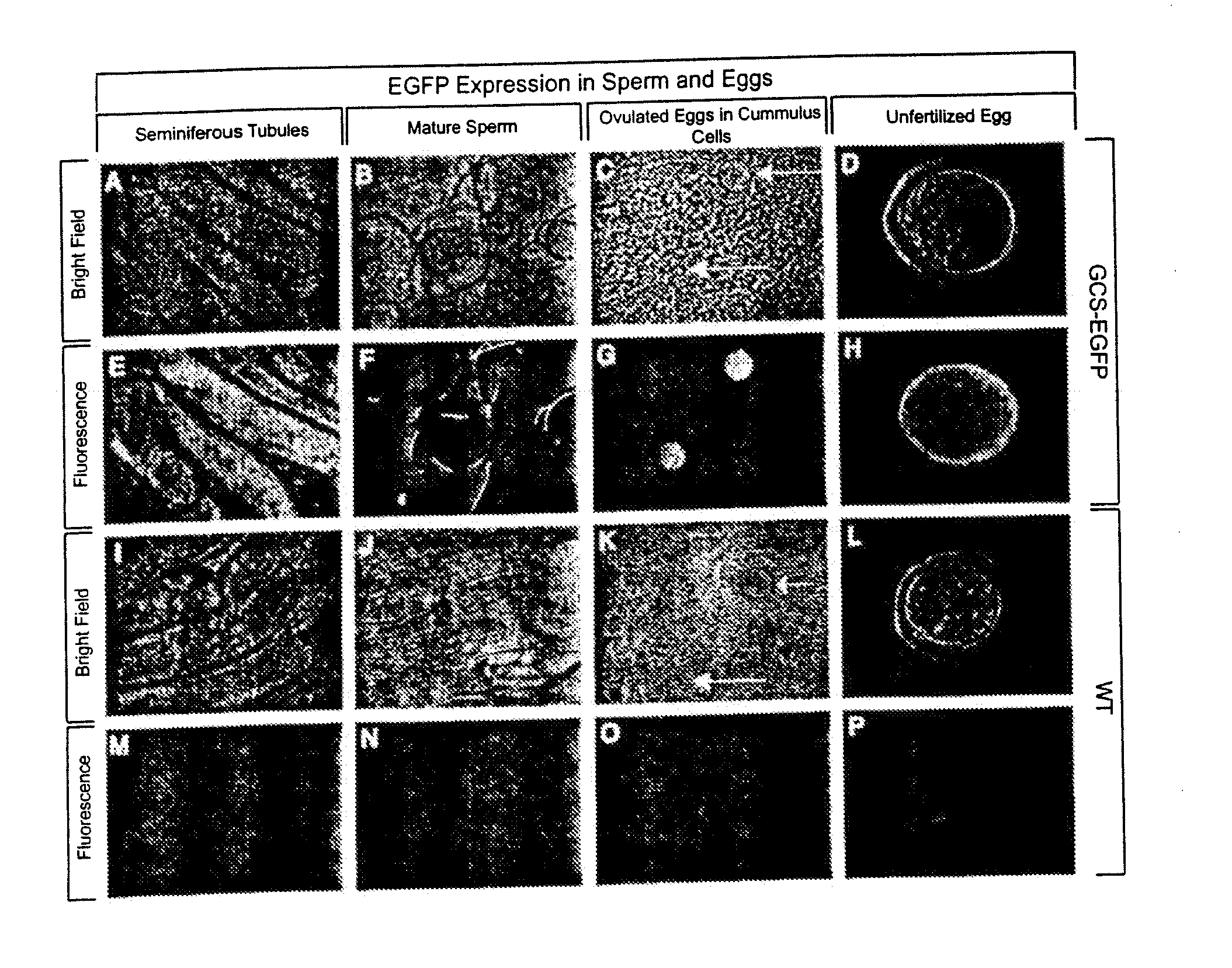Transgenic rats and spermatogonial stem cells
a technology of spermatogonia and transgenic rats, which is applied in the field of transgenic rats and spermatogonia stem cells, can solve the problem that spermatogonia cannot be propagated in culture in rats
- Summary
- Abstract
- Description
- Claims
- Application Information
AI Technical Summary
Benefits of technology
Problems solved by technology
Method used
Image
Examples
example 1
Generation and Characterization of Rosa-EGFP Transgenic Rat Lines
A. Construction of ROSA-EGFP Transgene and Production of Transgenic Rats.
[0032] A 0.8 Kb SalI-BamHI ROSA26 fragment (Ref. 14) was inserted between the SalI and BamHI restriction sites of the EGFP-N1 plasmid from Clontech to generate the ROSA-EGFP transgene (Ref. 14-15). The 1.8Kb SalI and AlfII ROSA-EGFP fragment was separated from vector DNA by gel electrophoresis and the fragment was isolated from the gel by perchlorate elution. Transgenic rats were produced by microinjection of the 1.8 kb ROSA-EGFP fragment into the pronucleus of Sprague Dawley rat eggs as described (Ref. 16); 6 transgenic rats were produced. Founders were mated with Sprague Dawley wild-type (WT) rats and 4 independent lines were established. Genotyping of founders was by dot blot analysis and progeny by either dot blot or PCR analysis of genomic DNA isolated from tail biopsies. PCR was performed using the forward primer EGFP5-1 (5′AACTTCAGGGTCAG...
example 2
Characterization of the Transgene Insertion and Assignment of the Transgene Chromosomal Position
FISH Analysis.
[0040] Rat embryonic fibroblasts were isolated from E15.5 homozygous embryos by standard procedures (Ref. 18). Slides for cytogenetic analysis were prepared essentially as previously described (Ref. 19). Briefly, cell cultures were treated with 0.2 mg / ml of 5′-bromo-2′-deoxyuridine (BrdU) for 17 hours. Subsequently, the cells were washed three times and cultured for 6 h in medium supplemented with 0.05 μg / ml thymidine. Mitotic figures were accumulated by adding 0.05 μg / ml Colcemid (Sigma Aldrich. St. Louis, Mo.) during the final 30 min., and metaphase cells were harvested by mitotic shake-off, a procedure which selects cells which have entered mitosis and have become morphologically rounded which allows them to become easily detached from the culture plate by gentle shaking. The cells were resuspended in 0.07 M KCl at room temperature for 10 min, washed, and fixed in thre...
example 3
Transgene is Expressed in the Epiblast, Genital Ridge, Embryonic Gonads, and Adult Germ Cells
[0043] The EGFP expression pattern in post-implantation embryos (E8.5-E19.5) were examined by fluorescence microscopy. EGFP fluorescence was first observed in the proximal epiblast with a small population of cells displaying strong fluorescence on E8.5 (FIGS. 4A, 4I); these are conceivably primordial germ cells (PGC). In E13.5 embryos, the genital ridge (FIGS. 4B, 4J) showed strong fluorescence while the adjacent mesonephros was devoid of an EGFP signal. In E15.5 embryos, the male and female genital ridges can be distinguished from each other in that the male genital ridge (FIGS. 4D, 4L) exhibits a distinct cording pattern while the female ridge is mottled (FIGS. 4C, 4K). The genital ridges from both sexes of the GCS-EGFP rats were strongly fluorescent. The male and female embryonic gonads (FIGS. 4M, 4N) also showed strong EGFP fluorescence while the surrounding somatic support tissues were...
PUM
| Property | Measurement | Unit |
|---|---|---|
| Electrical resistance | aaaaa | aaaaa |
Abstract
Description
Claims
Application Information
 Login to View More
Login to View More - R&D
- Intellectual Property
- Life Sciences
- Materials
- Tech Scout
- Unparalleled Data Quality
- Higher Quality Content
- 60% Fewer Hallucinations
Browse by: Latest US Patents, China's latest patents, Technical Efficacy Thesaurus, Application Domain, Technology Topic, Popular Technical Reports.
© 2025 PatSnap. All rights reserved.Legal|Privacy policy|Modern Slavery Act Transparency Statement|Sitemap|About US| Contact US: help@patsnap.com



